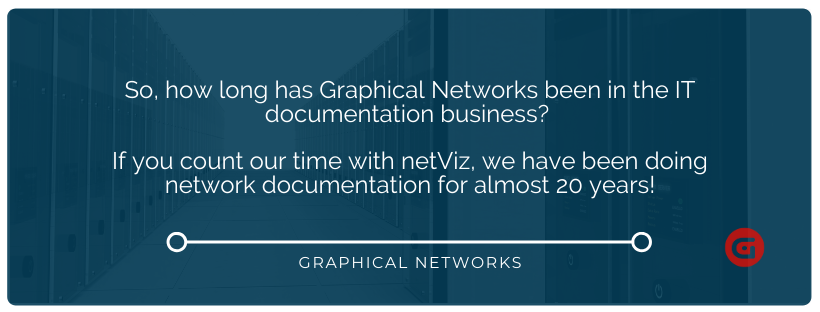
Back in the early 1990’s, a company based in Gaithersburg, Maryland, offered a desktop-based, IT documentation system called netViz. netViz did what it did great. It gave users the ability to document networks, data centers, and enterprise architecture diagrams. Users were using netViz to document its data center racks and cables, well before the term ‘Data Center Infrastructure Management’ (DCIM) was even coined! I, like many of the founding members of my team here at Graphical Members, worked at netViz…and I can remember we were hearing of companies like Aperture, Visionael, and other first-generation DCIM at netViz.
What was netViz? It was a desktop tool to visualize information from networks, data centers, and so on — with add-on web-based tools to publish netViz projects via netViz WebView or netViz Enterprise. This was the direction netViz was heading towards, moving to the web, before its parent company, Computer Associates (CA) decided to sunset the product, way back in 2012.
So, how long has Graphical Networks been in the IT documentation business? Well…if you count our time in netViz, we have been doing network documentation for almost 20 years! Graphical Networks was founded in 2007 by former netViz employees. Our office is less than 2 miles from the former netViz office in Gaithersburg, Maryland! With that said, I think it’s safe to say that our staff knows a bit about what organizations are looking for when it comes to network and data center documentation — dating all the way back to the 1990’s.
Our first software was delivered (it was called myGIS before changing the name to netTerrain) in 2009. We’ve come a long way since then, and certainly a very long way since our netViz days!
If netViz was discontinued almost eight years ago, why am I writing about this now? Though the majority of our new customers haven’t used and/or heard of netViz before, we’ve seen some new customers recently who do need to migrate their existing netViz projects into netTerrain.
Why netTerrain?
One good reason: because of our long history with netViz and old-school IT documentation software, we are the only company that can import existing netViz projects!
Additionally, netTerrain is an affordable, complete IT documentation solution, encompassing:
- Data Center Infrastructure Management (DCIM)
- Network Asset Inventory
- Application, System and Topology mapping
- Cable and Circuit Management
- Outside Plant
Unlike netViz however, netTerrain, is a client-server application, with a richer web-based feature set, including:
- Unlimited zooming and panning
- Ability to move and resize nodes on a diagram
- Browser based arrange and graph layout features
- Ability to filter objects through the browser
- Ability to add, edit and delete nodes and its attributes just using a browser
Because netTerrain is natively web-based, if you’ve been a netViz user you’ll be excited to hear that you will no longer need to create and save multiple netViz projects any longer— and there is no need to publish data to the web. Your diagrams are generated on-demand, concurrently, and in real-time. There is no need for project synchronizations and reconciliation of types.
While at netViz, our Product Manager and Engineering team created Adapters to CA network tools, eHealth and Spectrum to help automate the population of netViz projects. Here at Graphical Networks, we created what we call ‘the Collector’, to help populate and automate the data-driven diagrams.
You can automate the data and diagrams through netTerrain Collector:
- netTerrain network discovery engine with polling service
- Rest API connectors third party Network and Asset Management
- Systems, such as:
- Additionally, you can import existing MS Visio diagrams, netViz projects, KMZ/KML diagrams, and spreadsheets
With netTerrain’s Collector, you can use automated discovery to leverage your existing data sources to reduce implementation time frame and ensure that your diagrams and data are up-to-date!
So, for exiting netViz users, who are experiencing issues with newer versions of Windows, or management finally decides to find a new supported software application, take a look at netTerrain. For netViz users, you’ll experience a smooth transition and migration from netViz to netTerrain (and, the learning curve in using netTerrain is minimal).
